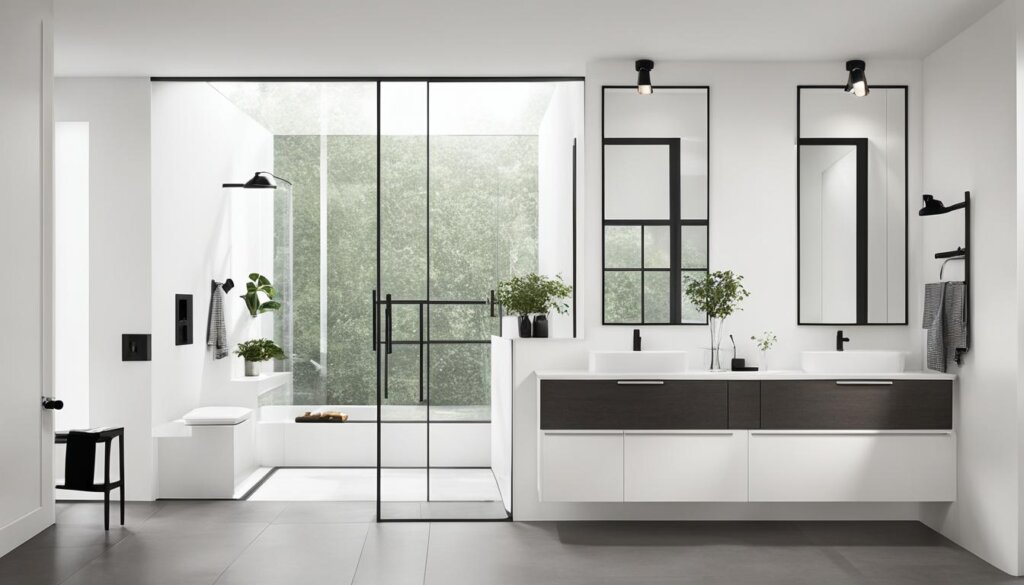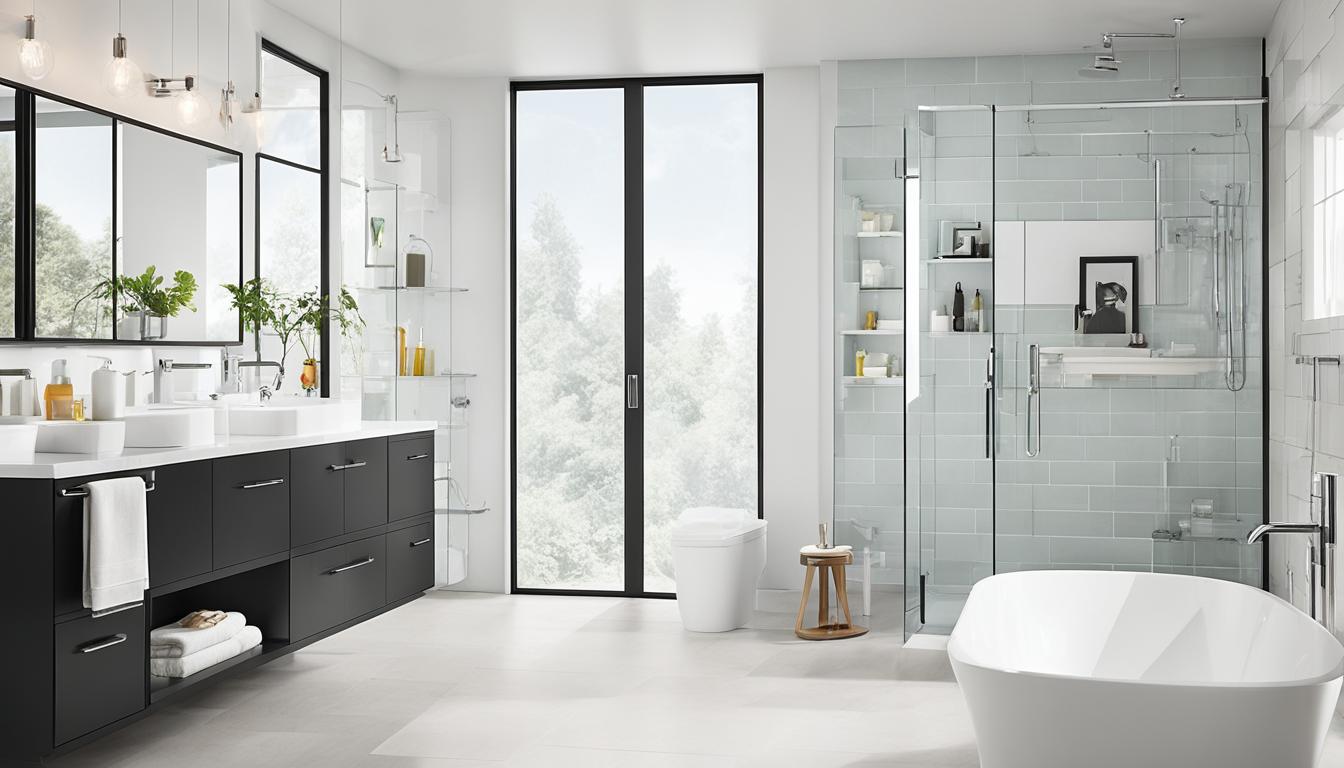Welcome to our guide on Bauhaus-inspired design for contemporary bathrooms. Bauhaus design originated in Germany in 1919 and revolutionized modern design by emphasizing functionality, simplicity, and minimalism. By incorporating Bauhaus principles into your bathroom, you can create a space that seamlessly blends functionality and aesthetic appeal.
A modern Bauhaus bathroom takes inspiration from the Bauhaus interior style, which is characterized by clean lines, geometric shapes, and the innovative use of industrial materials. A minimalist approach to design ensures a clutter-free space, promoting a sense of calm and relaxation. Whether you’re renovating or designing a new bathroom, we will provide you with expert tips and ideas to create a functional and visually appealing Bauhaus bathroom.
From Bauhaus bathroom fixtures to Bauhaus bathroom accessories, we will explore how to incorporate key elements of Bauhaus design into your bathroom. Discover creative ways to incorporate curvy shapes, round basins, modular furniture, and floating basin units. We will also explore Bauhaus colors and textures, including dark wooden furniture and the use of primary colors to create bold accents. Additionally, we will discuss how lighting plays a crucial role in bringing out the best in your Bauhaus-inspired bathroom, with a focus on natural light and mirrors.
Get ready to transform your bathroom into a contemporary oasis with our inspiring Bauhaus bathroom ideas and modern design tips. Throughout this guide, we will help you navigate the world of Bauhaus design and provide practical insights to create a bathroom that not only meets your functional needs but also showcases your impeccable taste in design.
The Origins of Bauhaus Design
Welcome to the fascinating world of Bauhaus design! To understand this influential movement, we need to delve into its origins and the vision behind it. The Bauhaus School, founded by Walter Gropius in Germany in 1919, was a response to the changing times brought about by the industrial age.
The Bauhaus School aimed to bridge the gap between art, craft, and technology, creating designs that were not only aesthetically pleasing but also practical and functional. It drew inspiration from the Arts and Crafts movement’s emphasis on craftsmanship and traditional techniques, but also embraced the new materials and technologies of the industrial age.
At its core, Bauhaus design sought to break down the boundaries between art and industry, combining artistry with the efficiency and mass production possibilities of modern technology. By integrating art, craft, and technology, the Bauhaus School aimed to create a new type of designer who could navigate the challenges of the modern world.
By offering a comprehensive curriculum that focused on a wide range of artistic disciplines, including painting, sculpture, architecture, typography, and industrial design, the Bauhaus School encouraged students to explore and experiment with different materials and techniques. This interdisciplinary approach fostered collaboration and innovation, challenging traditional design norms.
Through its emphasis on simplicity, functionality, and the concept of “form follows function,” Bauhaus design revolutionized the field of modernism and became a driving force in shaping the aesthetics of contemporary architecture and design.
Take a moment to visualize the principles of Bauhaus design. Here is an image that encapsulates its essence:

Now that we have explored the origins of Bauhaus design, let’s dive deeper into the founding of the Bauhaus School and the key principles and philosophies that guided its approach.
The Founding of the Bauhaus School
When it comes to the origins of Bauhaus design, we cannot overlook the significant role played by Walter Gropius. In an effort to revolutionize art education and bring together artists, designers, and craftsmen, Gropius founded the Bauhaus School. This institution, established in 1919, aimed to break down traditional barriers and create a collaborative environment for creative minds to thrive.
Gropius had a vision of a new type of designer who could integrate both manual skills and intellectual thinking. Accessibility was at the forefront of his mind, as he sought to give everyone the opportunity to engage in art education. This inclusive approach meant that individuals from diverse backgrounds could come together and contribute their unique perspectives to the world of design.
The curriculum of the Bauhaus School reflected Gropius’ interdisciplinary approach and commitment to “learning by doing.” Rather than focusing solely on theoretical concepts, students were encouraged to experiment with various materials and techniques. Courses in painting, sculpture, architecture, typography, and industrial design were offered, providing a comprehensive education that nurtured well-rounded creatives.

The Bauhaus School’s emphasis on practicality and functionality extended beyond the classroom. Its buildings were designed with the same principles in mind, reflecting the fusion of art and architecture. The school’s premises themselves served as a testament to the innovative ideas and forward-thinking mindset of the Bauhaus movement.
By fostering a culture of collaboration, exploration, and hands-on learning, the Bauhaus School laid the groundwork for a new era of design. Its influence can still be felt today, as the principles and philosophies it established continue to shape the way we approach art and creativity.
Key Principles and Philosophies
In the world of Bauhaus design, several key principles and philosophies guided the movement. These principles encompassed the innovative use of industrial materials, the emphasis on simplicity and functionality, and the iconic concept of “form follows function.”
- Industrial Materials: Bauhaus designers embraced the use of industrial materials such as steel, glass, and concrete. These materials were celebrated for their durability, affordability, and modern aesthetic. By incorporating these materials into their designs, Bauhaus artists created products that were accessible to a wider audience, challenging the notion that art and design were only for the elite.
- Simplicity: The principle of simplicity was central to Bauhaus design. Clean lines, minimal ornamentation, and a reductionist approach were the hallmarks of this style. Bauhaus designers sought to remove unnecessary embellishments and focus on the essential elements, allowing the pure form and function of their creations to shine through.
- Functionality: Bauhaus design prioritized the functional aspect of objects. Every element had a purpose and served a specific function. The focus on functionality meant that objects were designed with usability in mind, making daily life more efficient and enjoyable.
- Form Follows Function: Bauhaus designers believed that the form of an object should be dictated by its intended function. This principle meant that the design of an object should be a direct response to its purpose. The aesthetic beauty of an object should arise naturally from its functionality, exemplifying the seamless integration of form and function.
In addition to these fundamental principles, the Bauhaus movement also emphasized collaboration and teamwork. Bauhaus designers recognized the value of collective contributions, fostering a spirit of collaboration that encouraged students to work together on projects and share ideas. This collaborative approach broke down traditional barriers between different disciplines and led to the development of innovative and interdisciplinary designs.

The use of industrial materials, the dedication to simplicity and functionality, and the concept of form follows function are the key principles that define the Bauhaus movement. Embracing these principles allows designers to create modern, elegant, and timeless pieces that continue to inspire contemporary design and architectural practices.
Influential Bauhaus Artists and Designers
The Bauhaus School attracted influential artists and designers who played a significant role in shaping the aesthetics of the movement. Among them were Josef Albers, Paul Klee, and Wassily Kandinsky.
Josef Albers, known for his innovative use of color, was a prominent figure at the Bauhaus Design School. He explored color theories and their relationship to form, creating vibrant compositions that captivated viewers. Albers’ work continues to inspire contemporary designers in their exploration of color palettes and combinations.
Paul Klee, a Swiss-German artist, brought his artistic expertise and unique style to the Bauhaus School. His whimsical and imaginative artworks incorporated elements of cubism, expressionism, and abstract art, pushing the boundaries of traditional artistic conventions. Klee’s emphasis on geometry and experimentation with form resonated with the Bauhaus philosophy.
Wassily Kandinsky, a Russian artist, was another influential figure at the Bauhaus School. His abstract works delved into the spiritual and emotional aspects of art, relying on shapes, colors, and lines to convey meaning. Kandinsky’s exploration of geometric shapes and bold colors aligned closely with the principles of minimalism and abstraction embraced by the Bauhaus movement.
Collectively, these influential artists and designers contributed to the development of Bauhaus aesthetics, which focused on minimalism, geometric shapes, and bold colors. Their work and teachings continue to inspire contemporary designers to explore new possibilities and challenge traditional design norms.

Incorporating Bauhaus Design into Your Home
If you’re looking to bring the elegance and functionality of Bauhaus design into your home, there are several key elements to consider. Start by focusing on functional furniture pieces that embody the Bauhaus aesthetic. Opt for floating basin units and modular furniture that not only serve a purpose but also add a touch of contemporary style to your space.
Emphasize curvy shapes in your furnishings and fixtures, as the Bauhaus movement embraced the organic forms and fluid lines. Consider incorporating a round basin or a P-shaped bath to add a visually appealing element to your bathroom design.
When it comes to colors and textures, look to Bauhaus-inspired palettes. Dark wooden furniture provides a sense of warmth and sophistication, while primary colors create a bold and impactful statement. Experiment with Bauhaus textures, such as natural materials and finishes, to add depth and visual interest to your interiors.
To enhance the overall ambiance, lighting plays a crucial role. Create a Bauhaus-inspired lighting scheme by maximizing the use of natural light and strategically placing mirrors to reflect and amplify the brightness. This clever trick of the light will not only brighten your space but also enhance the overall aesthetic.

